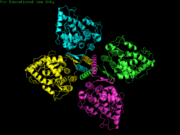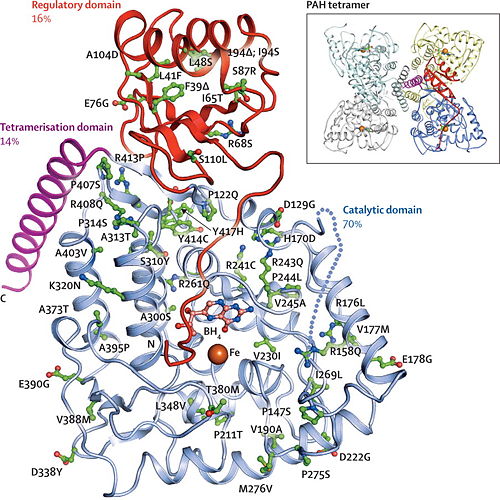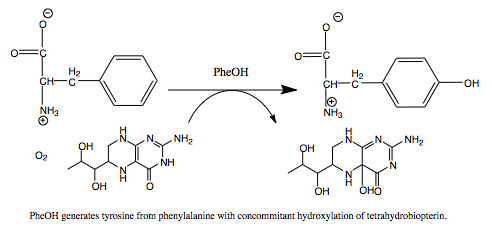Sandbox Reserved 480
From Proteopedia
| This Sandbox is Reserved from 13/03/2012, through 01/06/2012 for use in the course "Proteins and Molecular Mechanisms" taught by Robert B. Rose at the North Carolina State University, Raleigh, NC USA. This reservation includes Sandbox Reserved 451 through Sandbox Reserved 500. | |||||||
To get started:
More help: Help:Editing For more help, look at this link: http://www.proteopedia.org/wiki/index.php/Help:Getting_Started_in_Proteopedia
Phenylalanine Hydroxylase
Phenylalanine Hydroxylase (PheOH) is a type of enzyme involved in the catalization of phenylalanine into tyrosine.It belongs to the family of tetrahydrobiopterin (BH4) dependent aromatic amino acid hydrolase family of proteins.[1] Some other enzymes in this family include tyrosine hydroxylase and tryptophan hydroxylase. Below is a small scale phylogenetic tree of the different enzymes in this family. The human phenylalanine hydroxylase is labeled here as PH4H_HUMAN/119-450.[2] These enzymes add a hydroxyl group to the side chain of their corresponding amino acid. In order for this reaction to occur they are all dependent on BH4, as it acts as an electron carrier for the reaction. BH4 dependent aromatic amino acid hydroxylases are found in eukaryotic and some bacteria cells. In mammals PheOH is found mostly in the liver, where it can breakdown excess Phe from the diet. Mutations in this enzyme can lead to phenylketonuria (PKU), where phenylalanine builds up in the body and can cause mental retardation and other such symptoms. Hyperphenylalaninemia is a similar disorder, which also involves a disruption in the metabolic pathway of Phe. StructureThese structures have been identified using x-ray diffraction chrystallography. These hydroxylases are tetramers which contain homologous subunits. In this scene it can be viewed as a dimer. Each subunit is made up of three domains: the regulatory domain, catalytic domain, and tetramerization domain. The regulatory domain is in the N-terminus region of the chain. The catalytic domain is found in the middle nearing the C-terminus and the last set of residues make up the tetramerization domain, which helps form the tetrameric structure. The regulatory domain affects the function of the active site. When the regulatory domain is phosphorylated, the active site is closed off and prevented form interacting with the substrates. In this scene the chain is colored from N-terminus to C-terminus blue to red and the active site and Fe (III) is colored black. In the dephosphorylated PheOH, the active site is open to the subtrates and can convert them to products. Each subunit’s catalytic site is identified by an iron atom residing at the bottom of 10 Å deep cleft in the enzyme surface.[1] Fe is bound to three amino acid residues; His285, His290, and Glu184. Throughout the entire process of catalysis the Fe atom is in its ferrous form. This enzyme contains both hydrophobic and hydrophilic residues. Alpha-helices, loops, and beta-sheets can be found in each of the subuntis, though the helices are the more prominent secondary structure. PhenylketonuriaThe gene PAH codes for the PheOH protein. Mutations in PheOH can occur either from mutations within the gene or problems during transcription or tranlsation. These mutations in can alter one or many residues of PheOh and this can cause the enzyme not to function properly. These mutations could occur anywhere within the chain of the protein. The most prominent area where mutations were found to occur were within the catalyic domain.[3] Since PheOH is a key part in phenylalanine's metabolic pathway, the pathway will be disrupted and prevent Phe from being broken down. Phe will then build up in the body and has be found to affect the creation of the myelin sheath surrounding neurons, which results is mental retardation. There are many other symptoms to PKU such as heart problems, seizures, microcephalia, and also lighter skin and hair. Infants are usually tested for this disorder by the amino acid content of their blood or urine. If the disorder is caught early the patient can live normally with normal mental development and life span. This would mean creating a diet free of Phe and supplemented with tyrosine. Another type of disorder related to the phenylalanine metabolic pathway is hyperphenylalaninemia. In this case the enzyme is fully function but the tetrahydrobiopterin is defiecient. Without out this substrate the reaction will not be able to occur, creating a buildup of Phe, but not as great as in PKU. The affects of this disorder are less severe and can be manageable with the proper diet, which limits the intake of Phe. The image below depicts the possible mutations of the PheOH subunit in each of the three domains. It also gives a representative picture of the tetrameric structure.[3] MechanismCatalysis does not begin until all three substrates, oxygen, phenylalanine, and tetrahydrobiopterin, are bound to the enzyme. There are some inconsistencies with what order the substrates bind, but some studies suggest that the oxygen binds first and the order of Phe and tetrahydrobiopterin is interchangeable. The Glu residue of the active site is important in that it is the only direct connection between the the enzyme and the tetrahydrobiopterin. The substrates Phe and tetrahydrobiopterin get oxidized in this reaction, a hydroxyl group is added to the side chain. The products of the reaction include tyrosine and quinonoid dihyrdrobiopterin.
References
4. Fabrizia Fusetti, Heidi Erlandsen, Torgeir Flatmarki, and Raymond C. Stevens. Structure of Tetrameric Human Phenylalanine Hydroxylase and Its Implications for Phenylketonuria. JOURNAL OF BIOLOGICAL CHEMISTRY. 273 (27): 16962–16967 (1998)doi: 10.1074/jbc.273.27.16962 5. RCSB Protein Data Bank structures used: 1pah, 2pah, 1tg2, 1phz, 1kw0, 2phm. http://www.rcsb.org/pdb/results/results.do?outformat=&qrid=E47DFA3E&tabtoshow=Current |





